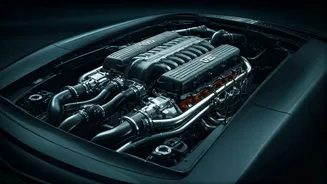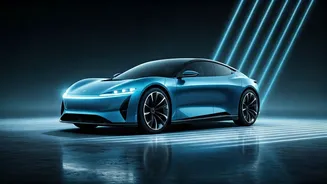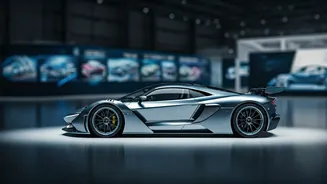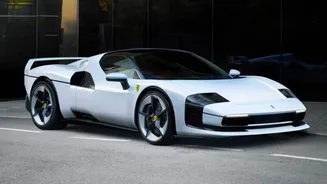Patent Filing Unveiled
The automotive world was recently abuzz with news of Porsche's patent application concerning a novel W12 engine configuration. This filing indicates a significant
stride in engine design, suggesting Porsche’s ongoing efforts to push the boundaries of automotive engineering. The W12 engine, known for its distinct configuration featuring cylinders arranged in a 'W' shape, has garnered significant recognition for its power and performance characteristics. This patent application is especially noteworthy because it represents Porsche's potential return to the W12 engine layout after a hiatus. This could signify a strategic move to optimize engine efficiency and power output, offering enhanced performance metrics for upcoming models. The patent offers technical insights into how Porsche envisions the construction and operation of this engine, focusing on factors like cylinder arrangement, combustion processes, and overall engine design. This suggests a comprehensive approach to improve the current engine design paradigms and explore potential advancements in automotive technology. The patent details serve as a window into Porsche's future plans for their engine technology and how they intend to maintain a competitive edge in the automotive market.
W12 Engine Configuration
The W12 engine is characterized by its unique design, where cylinders are grouped in a 'W' arrangement, which differentiates it from the more common V-shaped engine layouts. This configuration usually involves cylinders arranged in four banks, with three cylinders per bank, offering a compact and powerful package. This architecture offers distinct advantages, particularly in reducing engine length. This allows the engine to be fitted into a variety of vehicles with relative ease, especially those with stringent space constraints, while still achieving significant power outputs. Furthermore, the W12 design can contribute to enhanced engine balance. The careful positioning of the cylinders facilitates smooth operation, diminishing vibrations and enhancing overall refinement. Despite its complexity, the W12 engine delivers exceptional performance, often providing a blend of power and smooth operation that appeals to driving enthusiasts. This configuration’s inherent capacity for high-performance applications makes it an attractive choice for luxury vehicles and high-performance models. This design offers a compelling combination of power, balance, and compactness.
Anticipated Features
While specific details of the patent remain confidential, key aspects are hinted at, hinting at the potential inclusion of advanced technologies and design features. Such innovations may encompass advancements in fuel injection systems, aimed at enhancing combustion efficiency, along with improvements to the turbocharging system to amplify power delivery. These enhancements could significantly boost both performance and fuel economy. The engine could potentially incorporate advanced materials, such as lightweight alloys or high-strength steels. This selection of materials could contribute to a reduction in overall engine weight, thus improving the vehicle’s handling and responsiveness. The patent filing might also indicate enhancements in thermal management, like advanced cooling systems, designed to improve engine reliability and longevity, particularly in high-stress driving conditions. Furthermore, the design may feature adaptations to optimize emissions control, aligning with stricter environmental regulations. These features demonstrate Porsche's dedication to developing a powerful yet ecologically mindful engine, promising a future of automotive innovation.
Performance Expectations
The W12 engine, given its inherent design and potential engineering enhancements, is anticipated to deliver impressive performance capabilities. One can expect substantial power output, potentially exceeding the figures of existing engines, thereby promising quicker acceleration and heightened top speeds. Porsche's engineers would likely aim for exceptional torque delivery across a wide RPM range, resulting in immediate responsiveness and enhanced drivability. The integration of advanced technologies, such as sophisticated engine management systems, could further optimize performance by fine-tuning various engine parameters. These could include fuel delivery, ignition timing, and turbocharger boost, to maximize efficiency. Moreover, the W12's potential to be integrated into hybrid or electric vehicle systems could lead to even greater performance gains. This engine design could offer the power of a combustion engine while providing the benefits of electric assistance. This dual capability would offer consumers the best of both worlds, namely, power and increased fuel efficiency. This anticipated blend of power, torque, and responsiveness positions the W12 engine as a formidable contender in the high-performance car market.
Implications and Future
The patent filing has significant implications for Porsche's future product strategy and the broader automotive landscape. The re-introduction of a W12 engine signals Porsche's commitment to pushing technological boundaries. This technology suggests that the automaker is aiming to stay at the forefront of performance engineering. It could also influence the evolution of other engine designs. Innovations and discoveries from the W12 project may be adapted and integrated into various Porsche models, thereby benefiting the entire product portfolio. Furthermore, the W12 could potentially play a key role in Porsche's electric or hybrid initiatives. It could offer a high-performance, refined option in the hybrid and electric vehicle markets, increasing consumer choices. The launch of the W12 engine is likely to be viewed favorably by luxury car buyers. The engine configuration provides a unique selling proposition, strengthening brand image. This initiative underscores Porsche’s dedication to innovation, performance, and its role in shaping the future of the automotive industry.














